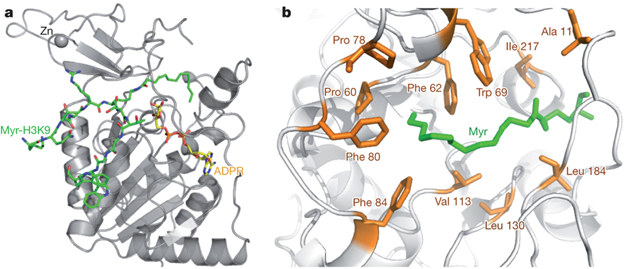About
News and Events
Beamlines
- User Facilities
- Beamlines Directory
- BL08U1-A
- BL08U1-B
- BL09U
- BL13W1
- BL14W1
- BL14B1
- BL15U1
- BL16B1
- BL17U1
- BL01B1
- BL17B1
- BL18U1
- BL19U1
- BL19U2
Technology
- Accelerator Physics
- Accelerator Operations
- Radio Frequency
- Beam Instrumentation
- Control Systems
- Electronics & Detector
- Mechanical Engineering
- Vacuum
- Magnets
- Magnet Power Supplies
- Pulse Technique
- Cryogenics
- Front Ends
- Optics
User Information
Science and Publications
SIRT6 Regulates TNF-α Secretion Through Hydrolysis of Long-chain Fatty Acyl Lysine
11-04-2013
The Sir2 family of enzymes or sirtuins are known as nicotinamide adenine dinucleotide (NAD)-dependent
deacetylases and have been implicated in the regulation of transcription, genome stability, metabolism and lifespan.
However, four of the seven mammalian sirtuins have very weak deacetylase activity in vitro. Here we show that
human SIRT6 efficiently removes long-chain fatty acyl groups, such as myristoyl, from lysine residues. The crystal
structure of SIRT6 reveals a large hydrophobic pocket that can accommodate long-chain fatty acyl groups. We
demonstrate further that SIRT6 promotes the secretion of tumour necrosis factor-α (TNF-α) by removing the
fatty acyl modification on K19 and K20 of TNF-α. Protein lysine fatty acylation has been known to occur in
mammalian cells, but the function and regulatory mechanisms of this modification were unknown. Our data indicate
that protein lysine fatty acylation is a novel mechanism that regulates protein secretion. The discovery of SIRT6 as
an enzyme that controls protein lysine fatty acylation provides new opportunities to investigate the physiological
function of a protein post-translational modification that has been little studied until now.
The research was conducted at the SSRF beamline 17U1.

Structure basis for SIRT6 activity with long-chain fatty acyl groups


 Copyright©2006.12 Shanghai Advanced Research Institute.
Copyright©2006.12 Shanghai Advanced Research Institute.